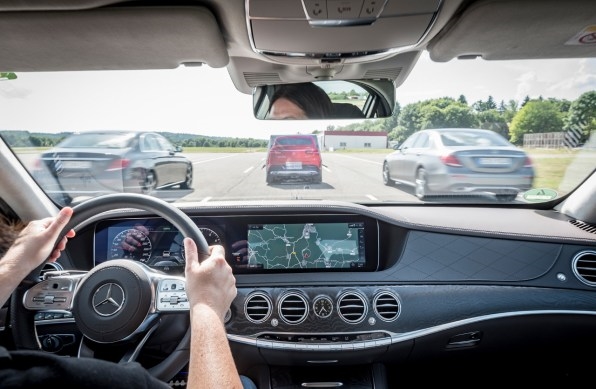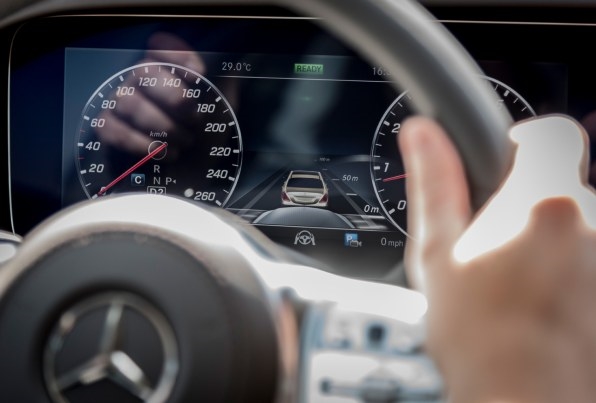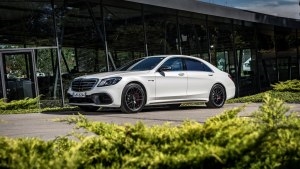The Future Has Arrived And It’s . . . A Self-Driving Car That Gives You A Spa Treatment?
By Jaclyn Trop , August 03, 2017
“Activate the pelvis,” a disembodied voice commands through the car’s audio system. “Tense your buttock muscles.”
It’s an unusual request from a car, but this isn’t any old sedan. This is the car of the future: The latest version of Mercedes-Benz’s six-figure flagship S-Class sedan, a plush, luxurious ride that the company also claims to be the most advanced self-driving vehicle currently on the market. Though it can’t fully drive itself, the company claims that because its computerized assistance lets the car focus on the driving, it frees you up to take part in a series of pre-programmed, mood-altering activities involving music, exercise, massage, and heat–and even aromatherapy.
As the car steers itself down a long stretch of highway, the voice–the standard GPS robotic woman’s tone–guides me through a range of seated ergonomic routines, from backside clenches to shoulder rolls to facial muscle exercises. “The exercises for the face are especially helpful because they make you smile and that stimulates happy feelings,” Daniel Mücke, head of Mercedes’s spa-like “Energizing Comfort” program, says from the seat beside me. “The body is made to move, and if you are driving for five hours, you are not moving,” Mücke says.

He scrolls through the interface and, on this slightly overcast day in July, selects the system’s Warmth mode. A jumble of yellow and orange lines flicker across the pair of 12.3-inch high-resolution display screens in front of us, mimicking the color and movement of a crackling fire. “You can use this one especially in winter for a cozy mood,” he says. Then the climate control system kicks in, strategically dispelling warm air throughout the cabin. “It’s not blown directly into your face,” Mücke explains. “Instead, the heat is on the surfaces, like the panels, steering wheel, and seats–with one push of the button.”
Mercedes’s Energizing Comfort program offers a glimpse of what we might expect once cars finally forego their steering wheels and shuttle us from point A to point B all on their own. As autonomous technology gets its sea legs, and more cars like the S-class are able to change lanes and steer around corners without help from the driver, the next question automotive engineers and designers must address is how people will spend their driving time once they no longer need to focus their attention on the road. Mercedes’s solution–a suite of software programs the company says are designed to promote feelings such as vitality, joy, and comfort using the sedan’s climate, audio, ambient lighting, massage, and “fragrance atomizing” systems–can address a range of ailments, from removing your road rage to massaging your backside to reminding you to smile.
“Let’s say you’re angry or nervous,” Mücke says, searching the menu. “The Wellbeing setting should definitely calm you down.” He pushes a button, and the cabin fills with slower music and a pink-and-purple light show. The seats initiate a gentle massage that feels like being in the pedicure chair at a nail salon. An atomizer in the glove compartment houses a scent cartridge and can put out a complimentary odor (you pick one scent–citrus, floral, leaves, and so on–when you purchase the car, but you can always buy more).

After a long day of test drives, my energy begins to flag, and Mücke suggests the Vitality setting. Designed to keep you awake and engaged, the system cues the upbeat music (it quickly scans and classifies songs from your library based on their beats per minute), cools the seats, and turns up the intensity on the massage. Meanwhile, the screens give away to a gradation of reds, “a power and passion color,” Mücke says. Though, as he concedes, “the meaning of the color red is culturally independent. It’s hard to find one color with the same meaning all over the world.”
What if you don’t need an attitude adjustment at all? The system is prepared for that, too. When you’re already feeling good, it will encourage you to stay that way, via the Joy mode’s coffee house-style music “that’s not too fast or loud,” unobtrusive massage, and yellow palette evocative of sunshine to stimulate positive thinking. “As long as I’m in a comfortable situation,” Mücke says, “this is the right program to keep me in the mood.”
Right now, drivers need to be self-aware enough to know what kind of mood they’re in and which mental state they want to achieve. But the next challenge for Mücke is to create a system that automates even the function of knowing one’s own self, and instead can read your physiological and psychological measurements, much the way a wearable device tracks your steps and sleep cycles, to tell you what you need. If the system detects high blood pressure, for example, the car would queue up slow music and soothing lights, which would definitely relax you and definitely not make your blood pressure increase even more. “That would be the next big step,” he says. “We still need a few years to get to that point.”
Though Mercedes’s sedan represents a significant step forward in driverless technology–and future models may even be capable of reading your mind and body, as Mücke hypothesizes–cars have still not advanced to the point where you can catch up on sleep while the vehicle makes all of the driving decisions for you. Fortunately, the car also retains its analog comforts of generations yore. If you truly need to relax and the fragrance program won’t cut it, assign someone else the driver’s seat, climb into the back, and rest your head on the fluffy pillows sewn into the back seats. It’s the best spot for a nap, I can attest.
Jaclyn Trop is a Los Angeles-based freelance reporter covering cars.
The new Mercedes S-Class has some impressive self-driving technology, but the real feature is what it does for you in the driver’s seat.
“Activate the pelvis,” a disembodied voice commands through the car’s audio system. “Tense your buttock muscles.”
Fast Company , Read Full Story
(18)













